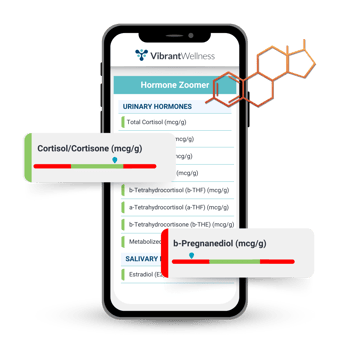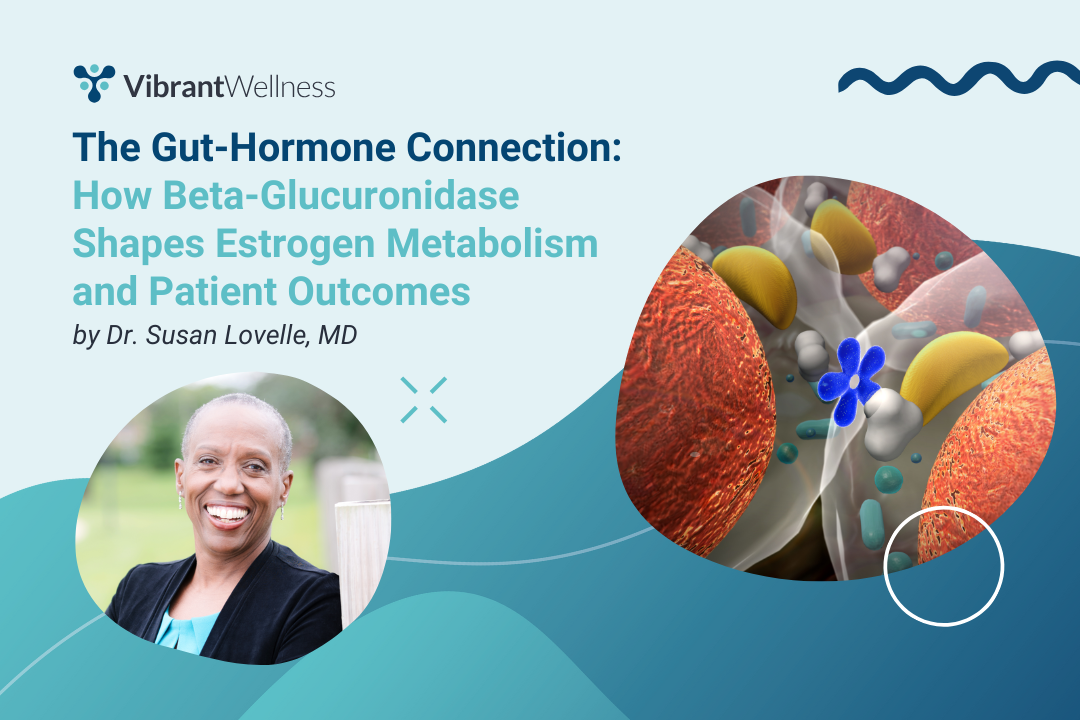Hormone imbalances are among the most common complaints we hear as functional and integrative medical practitioners. However, many of us are missing a crucial piece of the puzzle.
While serum and saliva hormone tests provide valuable insights, they often fail to show the complete picture. How hormones are metabolized, broken down, activated, and cleared from the body matters just as much as how much of a hormone is present. These metabolites influence symptoms, risks, and treatment outcomes.
Hormone metabolites are a critical but frequently overlooked data point. In this article, we explain why hormone metabolite testing like the Vibrant Wellness Hormone Zoomer can provide you with critical information to take hormone care to the next level. By understanding hormone metabolites, you can help close the loop between symptoms and effective, individualized care.
Table of Contents
What Are Hormone Metabolites?
Hormone metabolites are the downstream products formed when the body processes hormones. Once hormones like estrogen, progesterone, or cortisol are produced, they go through various enzymatic transformations to be activated, inactivated, or eliminated.
These steps involve methylation, hydroxylation, glucuronidation, and sulfation, all of which play key roles in hormone balance, detoxification, and symptom manifestation.
Why Do Hormone Metabolites Matter?
Traditional hormone testing (such as serum, saliva, and urine) typically focuses on total or free hormone levels. While these markers are important, they don’t reveal how well the body is managing those hormones.
For instance, someone may have normal estrogen levels but still suffer from estrogen-dominant symptoms if their metabolism favors pathways that increase inflammatory or genotoxic metabolites.
In other words, parent hormone levels can appear “normal” while downstream dysfunction silently drives hormone symptoms and long-term health risks.

Symptoms Without a Clear Cause
Many patients present with hormone-related symptoms that don’t match their lab results. Consider these examples:
- PMS with “normal” estrogen: A patient may have an estrogen level well within the reference range, but testing shows high levels of 16-OH or 4-OH estrogen metabolites, which are associated with symptoms such as heavy periods, bloating, and mood changes.
- Fatigue with low cortisol metabolites: While serum cortisol may look fine, downstream metabolite levels reveal insufficient adrenal output or poor cortisol clearance.
- Anxiety and high 4-OH estrogen: Elevated levels of 4-hydroxyestrone (4-OH E1) can contribute to oxidative stress and neurological symptoms, even if estradiol appears balanced.
Relying solely on parent hormones and traditional estrogen testing risks missing the underlying dysfunction, especially in complex cases involving chronic stress, endocrine disruptors, or impaired detoxification pathways.
Case Study: Fatigue and Estrogen Dominance
A 43-year-old woman presents with fatigue, brain fog, irritability, heavy menstrual bleeding, and weight gain in the midsection, hips, and thighs. She has tried bioidentical hormone therapy in the past, with limited success. She has a family history of depression and poor stress response. She also suffers from insomnia, often waking between midnight and 3:00 AM.
.png?width=2160&height=1440&name=%5BBLOG%20HEADER%5D%20PFAS%20eBook%20(1).png)
Initial Lab Results
Her serum estradiol, testosterone, and progesterone levels were within reference ranges. DHEA levels were low, and morning cortisol levels were normal.
Functional Hormone Testing
After her initial labs, the patient was given the Vibrant Wellness Hormone Zoomer test. Those findings included:
- Elevated 16-OH estrone: linked to estrogen dominance symptoms
- Low methylated 2-OH estrone: indicating poor methylation capacity
- Elevated beta-glucuronidase activity: suggesting impaired estrogen clearance through the gut-liver axis
- Elevated morning melatonin levels: suggesting a disrupted circadian rhythm, potentially causing grogginess, fatigue, and mood disturbances
- Decreased DHEA levels: indicating conditions like chronic stress or sleep disorders
- High cortisol levels at night: possibly contributing to insomnia, mood disorders, and hormonal disruptions, and potentially affecting fertility and menstrual regularity

Clinical Interpretation
Despite normal estrogen levels, this patient’s body was metabolizing estrogen in a way that favored more inflammatory and potentially proliferative pathways, while her methylation and conjugation pathways were sluggish. Chronic stress had elevated the patient's cortisol levels, lowered DHEA, and impaired sleep. Elevated morning cortisol confirms an issue with the patient's circadian rhythm.
Intervention
The patient focused on targeted nutrient support, including:
- Methyl B complex: Assists in methylation of sex hormones, aids in mood, and energy levels.
- L-Theanine: Given twice daily to support focus, mood, and stress symptoms.
- DIM: Supports healthy estrogen metabolism by promoting conversion of estrone to the safer 2-OH pathway and reducing 16-OH estrone levels. Helpful in addressing estrogen dominance symptoms.
- Calcium D Glucarate: Inhibits beta-glucuronidase activity, improving phase II estrogen detoxification in the gut-liver axis. Assists with estrogen clearance and reduces recirculation of toxic estrogen metabolites.
- Broad Spectrum Probiotic: Supports gut health, reduces beta-glucuronidase activity, and enhances estrogen detox. Crucial for maintaining the gut-liver axis and improving hormone elimination.
- Magnesium Glycinate: Helps regulate the HPA axis and manage cortisol levels. Rhodiola is better for morning fatigue; ashwagandha may support sleep and reduce nighttime cortisol.

She was also encouraged to make lifestyle adjustments, including:
- Stress management: Incorporating meditation, breathing techniques, and gentle exercise.
- Sleep hygiene: Choosing a consistent bedtime and ensuring light exposure in the morning.
- High-fiber diet: To aid in supporting estrogen clearance.
- Liver support: Drinking plenty of water and consuming a diet with cruciferous vegetables.
Outcome
After 12 weeks of therapeutic intervention, the patient reported improved energy, lighter menstrual cycles, and better mood regulation with minimal changes to her hormone levels. This underscores the power of addressing how hormones are metabolized, and not just how much is present.
Metabolite Patterns to Watch For
Hormone metabolite testing can help practitioners see patterns that may be contributing to symptoms in their patients.

4-OH Estrogens and DNA Damage
4-Hydroxy estrogens are catechol estrogens produced during estrogen metabolism. Elevated levels can generate reactive oxygen species and have been linked to DNA damage and cancer risk if not properly methylated. If oxidized, 4-OH estrone can react with DNA to form depurinating adducts. This may lead to cancer-initiating mutations that transform cells, thereby initiating breast, prostate, and other types of human cancer.
Testing these markers helps assess risk and guide antioxidant or methylation testing and support.
Methylated Estrogens
The ability to convert catechol estrogens into their methylated forms provides insight into methylation function. Poor methylation may reflect nutrient deficiencies, MTHFR SNPs, or toxic burden, and is highly actionable with nutritional therapy.
Cortisol vs. Cortisone Balance
The balance between cortisol and its inactive form, cortisone, can help assess adrenal resilience. Chronic stress, HPA axis suppression, or enzyme imbalances can skew this ratio, offering a more nuanced look into stress adaptation than serum cortisol testing alone.
Progesterone Metabolites
Metabolites like pregnanediol offer insights into true progesterone sufficiency, particularly in cases of infertility, anxiety, or luteal phase dysfunction. These markers can help determine whether progesterone production, metabolism, or excretion is the limiting factor.
How the Hormone Zoomer Helps
The Vibrant Wellness Hormone Zoomer makes complex hormone metabolite testing simple, accessible, and clinically actionable.
What It Measures
The panel measures: 
- Sex hormones: including estrogen, progesterone, and testosterone metabolites for both males and females
- Adrenal hormones: including cortisol, cortisone, and corticosterone metabolites
- Circadian and sleep-related hormones: including diurnal melatonin levels to help identify imbalances that may contribute to sleep disturbances.
- Endocrine-disrupting chemical markers: these can impact hormone function and metabolism
- Bone health: including bone turnover markers such as deoxypyridinoline (DPD) and pyridinoline (PYD), providing insight into aging, osteoporosis risk, and how hormone therapies may affect bone integrity
Designed for Integrative Care
The Hormone Zoomer test includes evidence-based nutritional and lifestyle recommendations, personalized to each metabolite profile. Additionally, Vibrant Wellness provides a team of health experts to assist in interpretation — ideal for busy integrative practitioners who treat difficult patient cases.
Key Takeaways
Measuring hormones without their metabolites is like reading only the headline of a clinical story: You risk missing the details that truly matter. Hormone metabolite testing reveals how hormones are being used, detoxified, and eliminated, offering deeper insights into symptoms and more precise treatment strategies.
By incorporating integrative hormone testing into your diagnostic toolbox, you can move from guesswork to targeted, personalized care, especially in cases where hormone therapy alone hasn’t worked.
The Hormone Zoomer test closes the loop between hormone levels and patient outcomes. For any unresolved fatigue, anxiety, hormone therapy resistance, or cycle irregularity, this is a panel you don’t want to skip.

About the Author
Dr. Logan Morse, PharmD, ABAAHP, FAAFRM, FACA, is an accomplished pharmacist and co-owner at Keystone Compounding Pharmacy in Grand Rapids, Michigan. He holds a Doctorate in Pharmacy from Ferris State University and is board-certified in anti-aging and functional medicine through the American Academy of Anti-Aging Medicine. Dr. Morse specializes in integrative and functional medicine. He works closely with patients on personalized health strategies, particularly in hormone replacement therapy, adrenal health, chronic fatigue, and sports medicine. Dr. Morse also serves in the United States Air National Guard, demonstrating his commitment to both his profession and his community. He is a passionate advocate for patient-centered care and is known for his deep dedication to helping patients achieve better health outcomes. Through tailored treatment plans and education on new treatment options, he aims to provide customized solutions tailored to improve patient outcomes.
Regulatory Statement:
The information presented in case studies have been de-identified in accordance with the HIPAA Privacy protection. The general wellness test intended uses relate to sustaining or offering general improvement to functions associated with a general state of health while making reference to diseases or conditions. This test has been laboratory developed and its performance characteristics determined by Vibrant America LLC and Vibrant Genomics, a CLIA-certified and CAP-accredited laboratory performing the test. The lab tests referenced have not been cleared or approved by the U.S. Food and Drug Administration (FDA). Although FDA does not currently clear or approve laboratory-developed tests in the U.S., certification of the laboratory is required under CLIA to ensure the quality and validity of the test.

.png?width=2160&height=1440&name=%5BBLOG%20HEADER%5D%20PFAS%20eBook%20(1).png)





.png)





